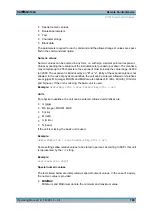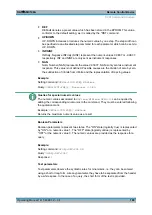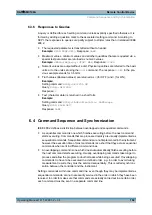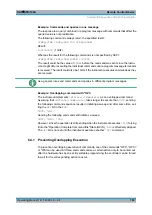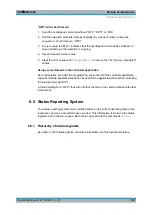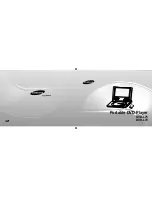
Remote Control Basics
R&S
®
SMC100A
202
Operating Manual 1411.4060.32 ─ 04
The parallel poll method is mainly used to find out quickly which one of the instruments
connected to the controller has sent a service request. To this effect, SRE and PPE must
be set to the same value.
6.5.5.4
Query of an instrument status
Each part of any status register can be read using queries. There are two types of com-
mands:
●
The common commands
*ESR?
,
*IDN?
,
*IST?
,
*STB?
query the higher-level reg-
isters.
●
The commands of the
STATus
system query the SCPI registers
(
STATus:QUEStionable
...)
The returned value is always a decimal number that represents the bit pattern of the
queried register. This number is evaluated by the controller program.
Queries are usually used after an SRQ in order to obtain more detailed information on
the cause of the SRQ.
6.5.5.5
Error Queue
Each error state in the instrument leads to an entry in the error queue. The entries of the
error queue are detailed plain text error messages that can be looked up in the Error Log
or queried via remote control using
SYSTem:ERRor[:NEXT]?
or
SYSTem:ERRor:ALL?
. Each call of
SYSTem:ERRor[:NEXT]?
provides one entry from
the error queue. If no error messages are stored there any more, the instrument responds
with 0, "No error".
The error queue should be queried after every SRQ in the controller program as the
entries describe the cause of an error more precisely than the status registers. Especially
in the test phase of a controller program the error queue should be queried regularly since
faulty commands from the controller to the instrument are recorded there as well.
6.5.6 Reset Values of the Status Reporting System
The following table contains the different commands and events causing the status
reporting system to be reset. None of the commands, except
*RST
and
SYSTem:PRESet
, influence the functional instrument settings. In particular,
DCL
does
not change the instrument settings.
Status Reporting System

